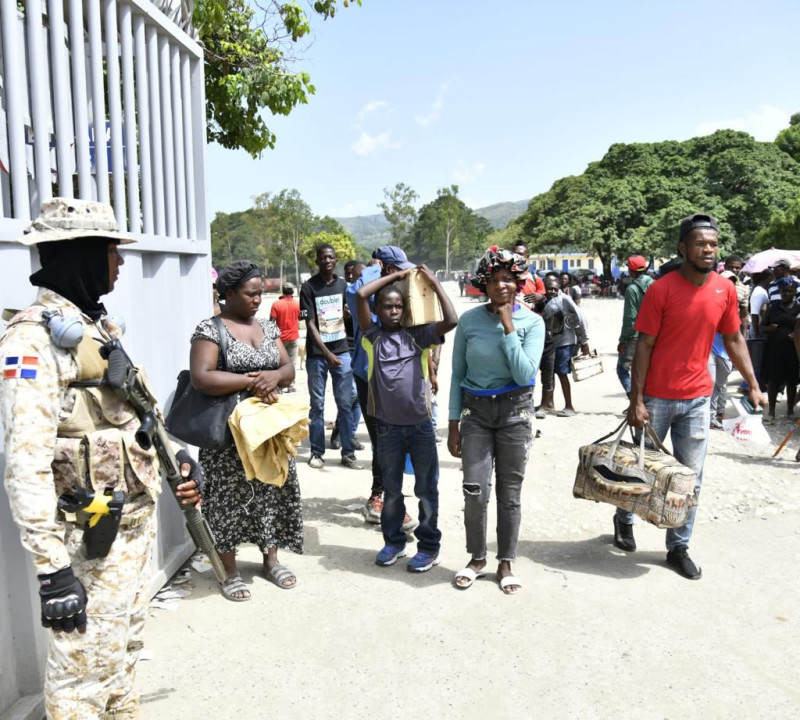Illegal migration madness on the Haitian border

Dominican military personnel were only seen in fortresses, observation posts and strategically erected checkpoints.JOSÉ ALBERTO MALDONADO/LD
My recent five-day trip to the border with Haiti allowed me to lay bare the twisted versions that always tell of everyday life here, controls of the illegal migratory torrent, harmony, and an entertaining life.
Thus said and reiterated, the border is, for the bulk of Dominicans who have never come to these impoverished lands, a “haven of harmony.”
But it is not so, because the social groups that live in our border towns suffer marginality, lack of work and optimal housing, low level of cultivation of their fertile lands, and lack of essential services to live and develop, as well as few possibilities to reach a solution to these obstacles.
The tour was developed through a narrow road with many shortcuts, hazardous secondary roads, in part much lower than a country road, with pits and muddy areas, always bordering dangerous cliffs.
As we moved through these distant spaces, the lands of Haiti, almost hand in hand with the Dominican lands, faded into the wheel of the transport unit, disappearing gradually and disintegrating its parts.
It all began in Jimani and ended in Dajabón, jumping tortuous stretches extending more than 223 kilometers and almost five hours of travel.
During the journey, no military patrols were seen. Only those stationed in fortresses, in observation posts and checkpoints strategically erected on hills, and others on the side of the road, were visible.
THEY ARE EVERYWHERE
Meanwhile, the Haitians were everywhere. They entered from the Dominican side and penetrated the forests, cut firewood for charcoal, and then returned, without problems, to their territory.
Haitian girls and teenagers would go out on the road to proposition for sex and beg for food. The most heartbreaking scene was of a little girl no more than seven years old who insinuated relationship proposals on the side of the road. At the same time, a short distance away, her parents, hidden behind a roadside shack, gave them directions through gestures.
Life on the border is a hell that barely begins in the arid, steep, and curved corridor of the mountains because when entering the inhabited towns, the marks of the people’s miserable life do not need masks.
If the version comes from a source of power, everything will be normal on the border, and if it is disseminated by a media tied to power, life here will not go beyond a “state of calm.”
But leaving both cases aside, the work committed to the truth unearths the misfortunes suffered by thousands of Dominican families subjected to challenges and threats to their spiritual and physical existence in these times of illegal immigration madness.
The people are the sole owners of their truth, which led to the work of the LISTÍN DIARIO service on this border of five provinces.
The highlight was to verify that, although the border has a military presence, the crossing of Haitians continues and continues to increase.
And that the prostitution of Haitian women is practiced freely in recreational parks, alleys, hills, brothels, and even inside vehicles. And minors, adolescents, and veterans practice it, many of them sick with HIV, syphilis, and tuberculosis, as revealed by a vaccinator at the Public Health Service in Elías Piña.
I called my work team, composed of three, for a visit to the park of Elías Pina to verify what we already knew about the case of prostitution. We arrived after 10:00 p.m. last Wednesday, and there they were. Some sit on benches, and others check on the sidewalks. There they gave us a price for the “business.”
What they were asking for, negotiating the time, would surely barely be enough to eat.
Pretending to the extreme so as not to arouse suspicions, we made the pretext of returning soon, leaving the place like hot rods.
The Haitians, men and women sell drugs and adulterated rum; they participate in robberies and assaults, rape, and commit crimes. They have control of the motoconcho service and have turned many streets in these towns into chaotic thoroughfares.
They defecate and urinate wherever they choose. They shout and fight and continually make scandals in public spaces. Begging is patent in these confines. In Dajabón, there are many drug addicts, beggars, and thieves who disturb day and night, although the same happens in Jimaní and Elías Piña.
One case that attracted a lot of attention was that in Jimaní and Elías Pina, no police officer was ever seen on duty in the streets.
Only the military was seen moving in units and stopping Haitians from searching them.
This is the reality of the land border with Haiti.


















This sounds like hell on earth.
I hope authorities(those allegedly in “charge”) going to do something about this …
Till then business as usual …
From what I’m reading, the military is not in control, the Haitian are in control of those lands
Agree. Border control on the Dominican side is quite weak and this is gonna bring the country a lot of problems.